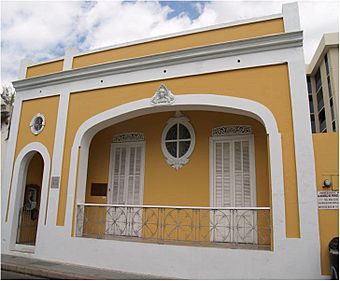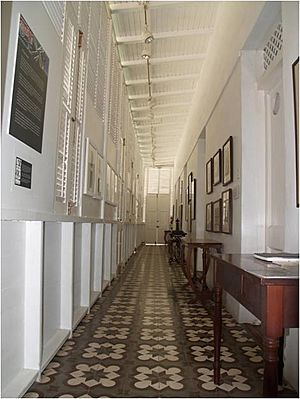Casa Paoli facts for kids
Quick facts for kids |
|
|
Casa Paoli
|
|

Main facade, in July 2009
|
|
| Location | 14 Mayor Street (now, 2648 Mayor St.), Ponce, Puerto Rico |
|---|---|
| Area | 1 acre (0.40 ha) |
| Built | c. 1864 |
| Architect | Manuel V. Domenech (1914 intervention) |
| Architectural style | Neoclassical |
| NRHP reference No. | 09000769 |
| Added to NRHP | 1 October 2009 |
| Established | 1987 |
|---|---|
| Location | Ponce, Puerto Rico |
| Type | Biographical museum |
| Owner | Private: Centro de Investigaciones Folklóricas de Puerto Rico, Inc. |
Casa Paoli (which means Paoli House in English) is a special historic house and museum in Ponce, Puerto Rico. It's located in the old part of the city. This house is famous because it was the birthplace of Antonio Paoli (1871–1946).
Antonio Paoli was a very talented singer, known as a tenor. He was the first person from Puerto Rico to become famous around the world for his singing. Many people consider him one of the best opera singers ever! He grew up in this house and first learned about art and opera here.
In 1987, the house became a museum to celebrate Antonio Paoli's amazing career. The United States government added the building to the National Register of Historic Places in 2009 because of its importance.
Contents
The Story of Casa Paoli
This house was a wedding gift for Antonio Paoli's parents. They got married at the Ponce Cathedral after their first five children were born. Antonio was their seventh child, and he was born right here in Casa Paoli. Two of his brothers and sisters were also born in this house.
Casa Paoli is important because it was the childhood home of one of the greatest opera singers of all time. It was where Antonio Paoli spent his early years. The house was also very close to Teatro La Perla, a major theater in Ponce. This made it easy for Paoli to go to many shows and get inspired.
Antonio Paoli had a powerful and beautiful voice. People called him the "King of the Tenors." He even sang for many kings and queens around the world, which is why he was also known as the "Tenor of the Kings."
What the House Looks Like
The front of Casa Paoli is very pretty. It has peach and white brick walls and a stucco front porch. The main balcony has a lovely arch with a female face carved above it. A smaller arched entrance leads into the porch and the house.
Beautiful iron railings from the early 1900s separate the porch from the sidewalk. The front doors are made of wood with louvers, a common style in the mid-to-late 1800s. You can also see a round window with fancy decorations on the front wall of the porch. Another small round opening is high above the archway.
Inside, the house has nine rooms. There's a long, bright hallway with many wooden shutters. A cobblestone path outside leads to a backyard.
The house's style is called Neoclassical, but it also has some features from the 20th century. It was first built as a wooden house before 1864. Antonio Paoli's father, Domingo Paoli, bought it then. By 1870, it had been improved with wood and brick. In 1914, a famous local architect named Manuel V. Domenech updated it to the brick and stucco building we see today.
Antonio Paoli's Life
Antonio Paoli was born in Casa Paoli on April 14, 1871. When he was young, he often went with his parents to watch opera shows at the Teatro La Perla. This theater was only about six blocks from his home. One amazing performance by an Italian singer named Pietro Baccei inspired Antonio to become an opera singer himself.
His parents supported his dream and enrolled him in a singing school. Sadly, when Antonio was just 12 years old, both his parents passed away. Antonio then moved to Spain to live with his sister, Amalia. She was also a singer and encouraged her younger brother to follow his dream.
Antonio studied at the Royal Monastery of El Escorial in Madrid, Spain, and at the Academia de Canto La Scala in Milan, Italy. He made his first big performance in Paris. After that, he received many awards and honors worldwide. People lovingly called him "The King of Tenors" and "The Tenor of the Kings."
He returned to Puerto Rico in 1917. Antonio and Amalia opened a singing school in San Juan. They also helped with theater shows at the San Juan Municipal Theater. In 1934, this theater was renamed The Antonio Paoli Theater to honor him.
Antonio Paoli passed away on August 24, 1946. He was first buried in Isla Verde, Puerto Rico. On April 13, 2005, his remains were moved to Ponce's Roman Baldorioty de Castro National Pantheon. Antonio Paoli is remembered as the first Puerto Rican to become famous internationally in music. The museum at Casa Paoli helps visitors learn about his amazing life and achievements.
The Museum and Research Center
Today, Casa Paoli is a museum and a research center focused on Puerto Rican culture. It is the main office for the Centro de Investigaciones Folkloricas de Puerto Rico (Puerto Rico Center for Folkloric Research). This center works to keep Puerto Rico's cultural traditions and popular arts alive.
The Center bought the house in 1987 to protect the history of Antonio Paoli and his family. Before moving to Casa Paoli in the spring or summer of 1987, the Center was located on Calle Marina street.
The museum has three rooms where you can see photographs, old postcards, and other items that belonged to Antonio Paoli. There's also a shop where you can buy colorful papier-mâché masks. These masks are used in Ponce's yearly Carnival celebrations. The museum shows documents and items from the singer's life, along with examples of Puerto Rican art and a history of the city of Ponce.
See also
 In Spanish: Casa Paoli para niños
In Spanish: Casa Paoli para niños
- List of music museums
- Corsican immigration to Puerto Rico
- National Register of Historic Places listings in Ponce, Puerto Rico



